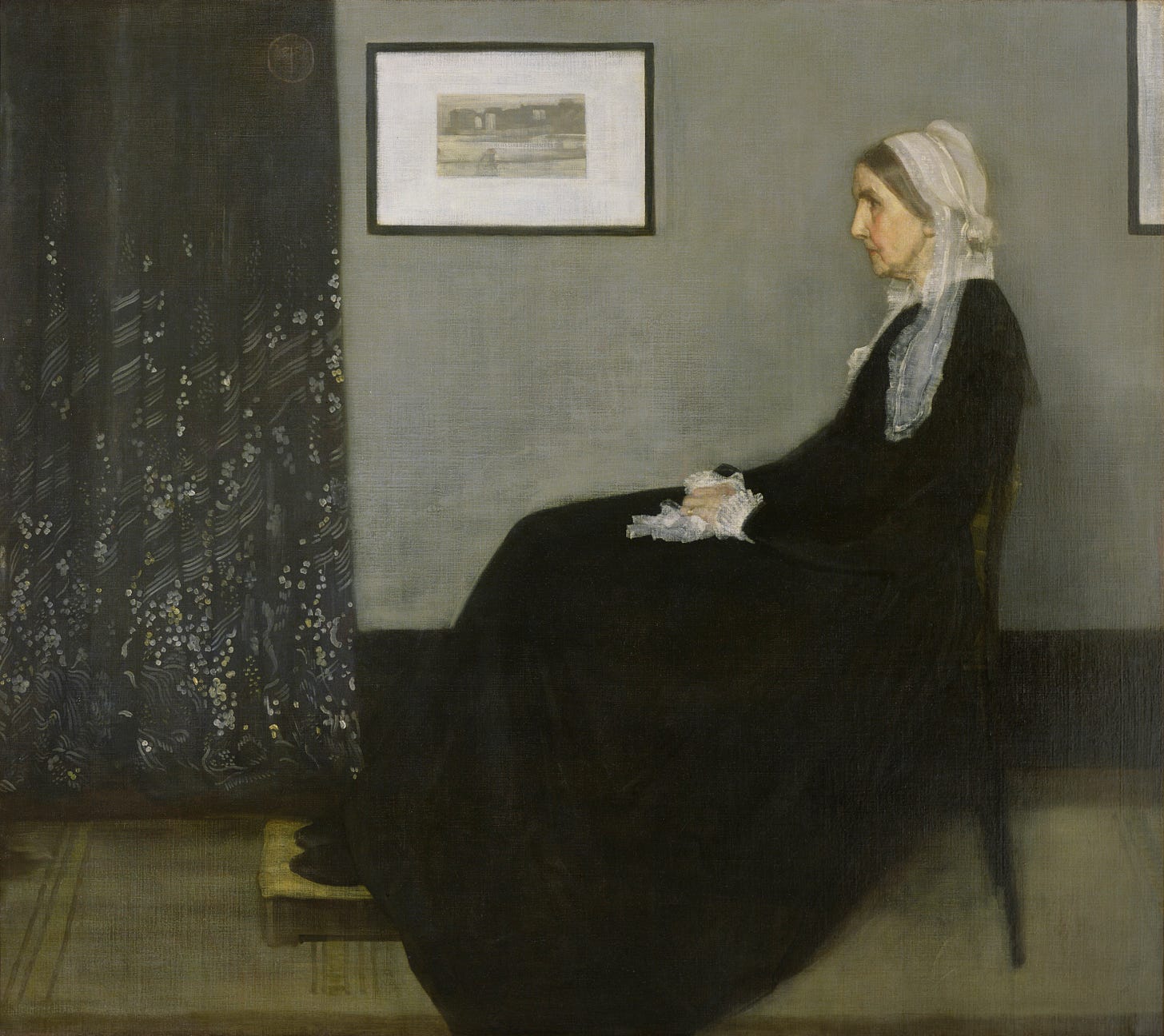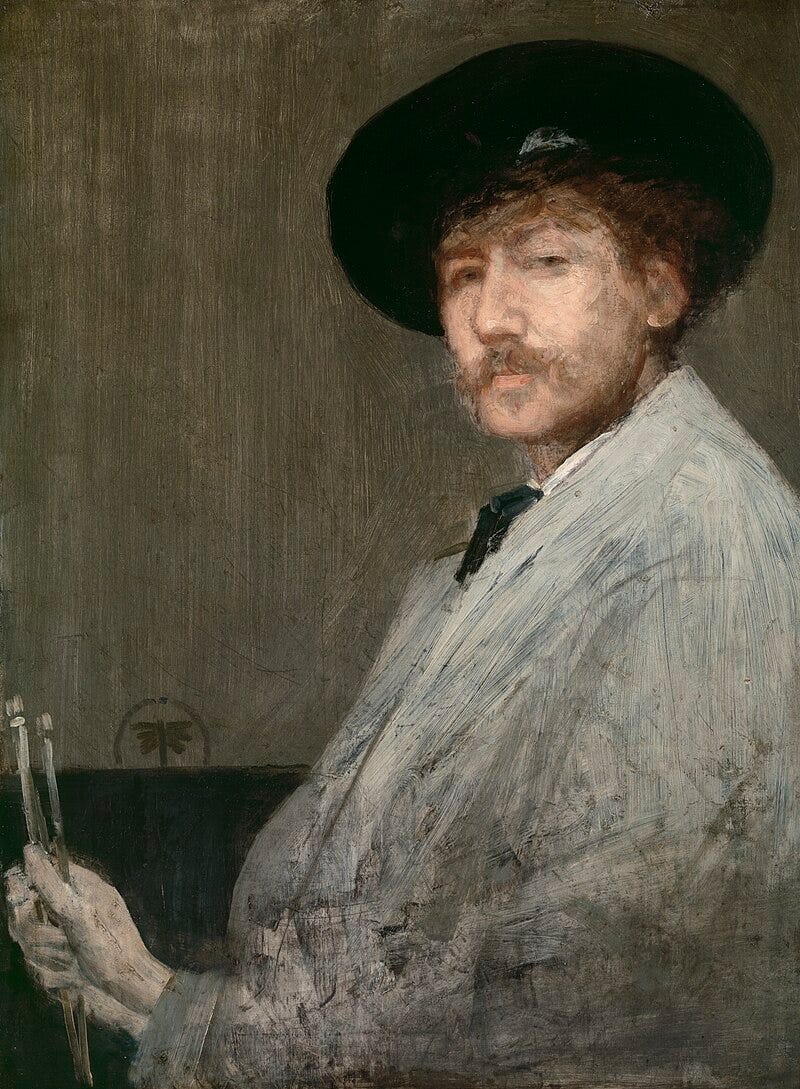With some paintings, it is their sheer complexity and scope of vision which elevates them to the status of an “iconic” masterpiece . . . as we see in Vincent Van Gogh’s swirling skies, or Michelangelo’s Sistine Ceiling.
With others, it is their extraordinary subtlety and sense of mystique which gains them acclaim- as we see in Vermeer’s Lady with a Pearl Earing, or Leonardo da Vinci’s Mona Lisa.
And at the same time- with the likes of Pablo Picasso or Henri Matisse - an iconic masterpiece may also be found sometimes in innovative forms or presenting a side of this world that no-one else could ever have even dreamed about before.
But every so often, a painting comes along and gains the same level of “iconic” status as all these other greats - yet the reasons it does so are much harder to define.
And that is exactly the case with today’s work by James McNeill Whistler

As one of the most famous paintings ever made by an American artist (Who, incidentally, was not even living in America at the time of painting it) - “Arrangement in Grey and Black No. 1” is often fondly referred to as “the Victorian Mona Lisa”.
Through an extremely touching depiction of a woman lost in thought, it can be read as a general tribute to the quiet dignity of old age - or, on a more sentimental level, as the ultimate way for an artist to pay homage to the woman who raised him.
But of course, to paint a portrait is one thing. To make it a masterpiece is quite another!
So in spending a little more time with this work together here, perhaps it’s worth us asking that key question; what exactly is it about Whistler’s painting that makes it so captivating?
It is not the colour scheme . . . with it’s muted greys and blacks.
Our leading lady does not wear ostentatious jewellery, nor a glamorous outfit, as we may see in the portraits of Jean-Auguste-Dominique Ingres.
And of course, the facial features of Whistler’s mother can hardly compare to the flawless beauty we find in works by Raphael or Botticelli.
Thus, in many ways, it is hard to really pinpoint exactly what makes this portrait so extraordinary. And when we also add the fact that our model actually takes up a relatively minor space in the overall composition too. . . frankly, it seems easier to look at that grey painting at the centre of the work more than anything else.
Yet still, in spite of all these elements which should work against this painting . . . it continues to captivate.
From the solemn colours, to the woman’s long distant stare, to the loneliness which seems to surround her . . . it feels wistful and melancholy in equal measures. And no doubt, this captures an emotion that so many of us will have felt too - perhaps when recalling a long distant memory, or reminiscing over the people we may have loved and lost in this life.
The painting itself was created while Whistler and his Mother were living together in London between 1864 & 1875. And according to some stories, the artist had actually originally intended to paint an entirely different woman for this picture. (Probably a younger model - which would have been much more in keeping with the kinds of women he had portrayed in countless other portraits)
But, when the model he had hoped for failed to turn up for her sitting - Whistler asked his mother to step in as a replacement instead. (Re-arranging the composition into a seated pose instead, because he knew that his mother would find it far too uncomfortable to remain standing for long.)

This may explain why we can sometimes notice a slight air of exasperation on his mother’s face too - as she sits there wondering just how her son has managed to drag her into sitting on this uncomfortable chair for the day!
But in truth, she had probably gotten rather used to getting caught in her son’s scheme’s over the years, because Whistler himself was certainly quite a character!
A flashy, swashbuckling man with devastating wit, and an unhealthy desire be famous . . . he often cast himself as a traditional English Dandy, and even locked horns at times with none other than Oscar Wilde - who once declared “Whistler spells Art “with a capital ‘I’.’
Thus, while he had invited his mother to live with him for practicality reasons and to look after her in old age - there was likely an equal motivation from her side also, to try and keep him out of too much trouble.
So, it is no surprise that when Whistler paints his own self portrait (above) shortly after painting that of his mother. . . he chooses a similar grey colour scheme too, almost as a way of establishing a permanent artistic connection between them.
And when we return again to our main work today - perhaps this brings us again to the real heart of this masterpiece.
The artist is capturing his mother as a woman who has faced so many struggles in her life . . . and, in these quiet moments, still mourns so much of what has happens.
Yet, even more than the sadness of age - Whistler focuses on the dignity instead; showing us just how much he admires this woman for the grace and strength she still conducts herself with.
_
Although of course, when asked about his motivations personally . . .Whistler himself would never have admitted to any of that.
After all - he had a reputation to keep up!!







Ambiguity is filled with so much possibility. Perhaps why such pieces are so captivating... the possibility is deeply felt. Simplicity layered with complexity. A resonance that extends far and wide—one we can’t quite pin point!✨
Even Americans who couldn't care less about art have at least heard of and seen images of paintings like American Gothic and Whistler's Mother. It's just one of those cultural icons. The Philadelphia Museum of Art had the painting on loan in the summer of 2023 so I got to see it. The most amazing thing about this painting (to me at least) was its size. It is huge. With the frame, it has to be at least 6" high by 8" wide. I was flabbergasted as having seen images of it all my life, I just assumed it was much smaller - like in the 2' by 3' range. If it were possible, I'd upload a photo I took of it relative to a doorway and people next to it.